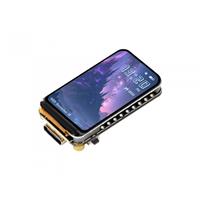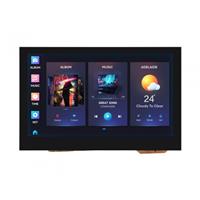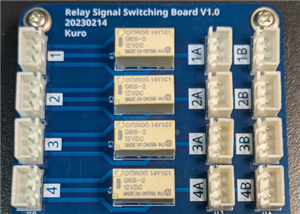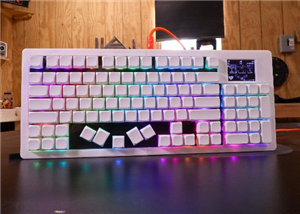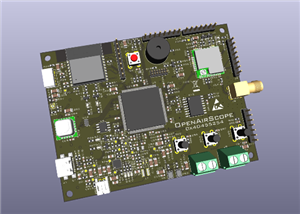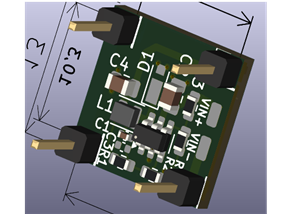Edoardo kinmami
JAPAN • + Follow
Edit Project
Description
Atari Commodore 64 Amiga Joystick Tester
Designed to test joysticks/pads with battery. It also acts as a dongle connected to the computer's port.
It works with standard Atari controllers up to three fire buttons.
Paddles (linear potentiometers) can be individually tested as well.
It uses low current LEDs which can easily driven by a 3V battery or thru the 5V line of the controller port.
Schematic and Layout

Jul 14,2021
3,132 views
Atari Commodore 64 Amiga Joystick Tester
Designed to test joysticks/pads with battery. It also acts as a dongle connected to the computer's port.
3132
16
10
Published: Jul 14,2021
Standard PCB
BOM(Bill of materials)
Purchase
Donation Received ($)
PCBWay Donate 10% cost To Author
Only PCB
PCB+Assembly
*PCBWay community is a sharing platform. We are not responsible for any design issues and parameter issues (board thickness, surface finish, etc.) you choose.
Copy this HTML into your page to embed a link to order this shared project
Copy
Under the
Attribution-NonCommercial-ShareAlike (CC BY-NC-SA)
License.
- Comments(10)
- Likes(16)
Upload photo
You can only upload 5 files in total. Each file cannot exceed 2MB. Supports JPG, JPEG, GIF, PNG, BMP
0 / 10000
It looks like you have not written anything. Please add a comment and try again.
You can upload up to 5 images!
Image size should not exceed 2MB!
File format not supported!
View More
-
 Engineer
Oct 22,2025
Engineer
Oct 22,2025
-
 Engineer
Aug 03,2025
Engineer
Aug 03,2025
-
 Jan Lunitz
Jun 08,2025
Jan Lunitz
Jun 08,2025
-
 przemoonn
May 21,2025
przemoonn
May 21,2025
-
 abdulhafizh
Jan 22,2025
abdulhafizh
Jan 22,2025
-
 Roman Kovář
Mar 16,2024
Roman Kovář
Mar 16,2024
-
 Panagiotis Katsiris
Jan 03,2024
Panagiotis Katsiris
Jan 03,2024
-
 Oliver Renz
Nov 12,2023
Oliver Renz
Nov 12,2023
-
 Mr. Marsupial
May 15,2023
Mr. Marsupial
May 15,2023
-
 gzepka
Mar 19,2023
gzepka
Mar 19,2023
-
 Shogun112
Jan 30,2023
Shogun112
Jan 30,2023
-
 Steven McGarr
Oct 15,2022
Steven McGarr
Oct 15,2022
-
 Benjamin Müller
May 26,2022
Benjamin Müller
May 26,2022
-
 frederic.piron
Mar 24,2022
frederic.piron
Mar 24,2022
-
 T-Bone
Jan 01,2022
T-Bone
Jan 01,2022
-
 Francisco Meza
Nov 19,2021
Francisco Meza
Nov 19,2021
View More
VOTING
0 votes
- 0 USER VOTES
0.00
- YOUR VOTE 0.00 0.00
- 1
- 2
- 3
- 4
- 5
- 6
- 7
- 8
- 9
- 10
Design
1/4
- 1
- 2
- 3
- 4
- 5
- 6
- 7
- 8
- 9
- 10
Usability
2/4
- 1
- 2
- 3
- 4
- 5
- 6
- 7
- 8
- 9
- 10
Creativity
3/4
- 1
- 2
- 3
- 4
- 5
- 6
- 7
- 8
- 9
- 10
Content
4/4
 More by Edoardo kinmami
More by Edoardo kinmami
-
 Commodore 64 1541-II 1581 Floppy Disk Drive C64 Power Supply Unit USB-C 5V 12V DIN connector 5.25
Compact design for high efficiency (>93%) USB-C Power Supply for Commodore 1541-II or 1581 Extern...
Commodore 64 1541-II 1581 Floppy Disk Drive C64 Power Supply Unit USB-C 5V 12V DIN connector 5.25
Compact design for high efficiency (>93%) USB-C Power Supply for Commodore 1541-II or 1581 Extern...
-
 V2 Commodore AMIGA USB-C Power Sink Delivery High Efficiency Supply Triple Output 5V ±12V OLED display ATARI compatible shark 100W
Version 2Compact design for high efficiency (>92%) USB-C Power Supply for Amiga 500, 600, 1200.Tw...
V2 Commodore AMIGA USB-C Power Sink Delivery High Efficiency Supply Triple Output 5V ±12V OLED display ATARI compatible shark 100W
Version 2Compact design for high efficiency (>92%) USB-C Power Supply for Amiga 500, 600, 1200.Tw...
-
 Commodore AMIGA PSU USB-C Power Sink Delivery Supply High Efficiency Triple Output 5V ±12V OLED ATARI ST shark
NEW VERSION https://www.pcbway.com/project/shareproject/V2_Commodore_AMIGA_USB_C_Power_Sink_Delivery...
Commodore AMIGA PSU USB-C Power Sink Delivery Supply High Efficiency Triple Output 5V ±12V OLED ATARI ST shark
NEW VERSION https://www.pcbway.com/project/shareproject/V2_Commodore_AMIGA_USB_C_Power_Sink_Delivery...
-
 Commodore AMIGA LED 500 600 1200 2000 status board multi system for debugging and troubleshooting hardware
A LED status PCB to connect A500, A600, A1200, A2000 motherboards for troubleshooting purposes witho...
Commodore AMIGA LED 500 600 1200 2000 status board multi system for debugging and troubleshooting hardware
A LED status PCB to connect A500, A600, A1200, A2000 motherboards for troubleshooting purposes witho...
-
 Commodore MAX Machine RF modulator replacement S-VIDEO bypass
Inspired by projects from c0pperdragon, mbarszcz-pcb, tebl and VGP.It fits the commodore MAX MACHINE...
Commodore MAX Machine RF modulator replacement S-VIDEO bypass
Inspired by projects from c0pperdragon, mbarszcz-pcb, tebl and VGP.It fits the commodore MAX MACHINE...
-
 Enhanced Flash Floppy Drive Plus (internal) with push-buttons gotek
Enhanced Flash Floppy Drive Plus Improved Gotek for Commodore Amiga (internal and external), Atari, ...
Enhanced Flash Floppy Drive Plus (internal) with push-buttons gotek
Enhanced Flash Floppy Drive Plus Improved Gotek for Commodore Amiga (internal and external), Atari, ...
-
 Commodore Amiga DB23 RGB VGA External Video Buffer (V6) Compatible with GBS-8200 8220 OSSC No Jail bars
External RGB video adapter from DB-23 female (input) to DE-15F (output, VGA) for Amiga computers.Com...
Commodore Amiga DB23 RGB VGA External Video Buffer (V6) Compatible with GBS-8200 8220 OSSC No Jail bars
External RGB video adapter from DB-23 female (input) to DE-15F (output, VGA) for Amiga computers.Com...
-
 Commodore Amiga 500 Plus + Chip RAM expansion to 2MB for Fat Agnus 8375 Rev 8
Commodore Amiga 500 Chip RAM expansion to 2MB for Fat Agnus 8375 mounted onto Rev 8.No modification ...
Commodore Amiga 500 Plus + Chip RAM expansion to 2MB for Fat Agnus 8375 Rev 8
Commodore Amiga 500 Chip RAM expansion to 2MB for Fat Agnus 8375 mounted onto Rev 8.No modification ...
-
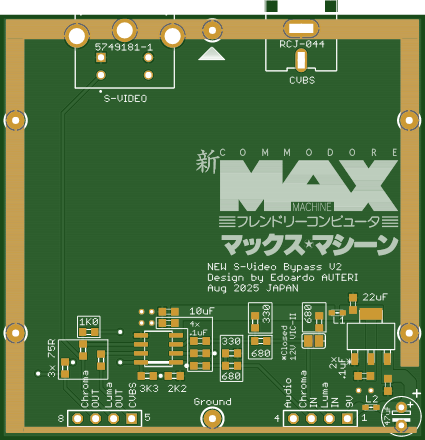 Commodore MAX Machine RF modulator replacement S-VIDEO COMPOSITE bypass V2
Inspired by projects from c0pperdragon, mbarszcz-pcb, tebl and VGP.It fits the commodore MAX MACHINE...
Commodore MAX Machine RF modulator replacement S-VIDEO COMPOSITE bypass V2
Inspired by projects from c0pperdragon, mbarszcz-pcb, tebl and VGP.It fits the commodore MAX MACHINE...
-
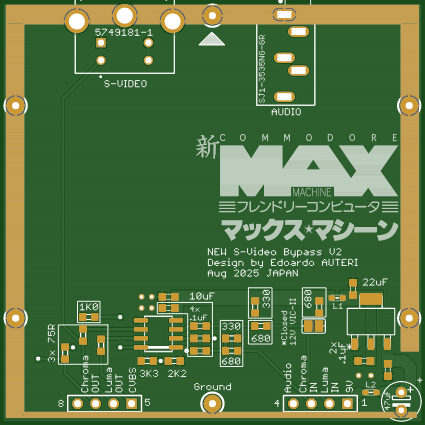 Commodore MAX Machine RF modulator replacement S-VIDEO AUDIO bypass V2
Inspired by projects from c0pperdragon, mbarszcz-pcb, tebl and VGP.It fits the commodore MAX MACHINE...
Commodore MAX Machine RF modulator replacement S-VIDEO AUDIO bypass V2
Inspired by projects from c0pperdragon, mbarszcz-pcb, tebl and VGP.It fits the commodore MAX MACHINE...
-
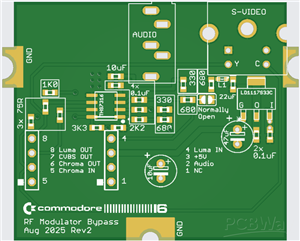 Commodore 16 (C16) Plus 4 RF modulator audio s-video replacement V2 C116 264 series
Commodore 16 (C16) & Plus/4 RF modulator replacementIt fits the commodore 16 & Plus/4 and re...
Commodore 16 (C16) Plus 4 RF modulator audio s-video replacement V2 C116 264 series
Commodore 16 (C16) & Plus/4 RF modulator replacementIt fits the commodore 16 & Plus/4 and re...
-
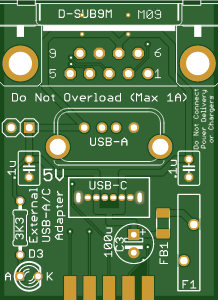 Commodore Amiga Atari Joystick Pad Mouse External Passthrough USB 5V adapter with ESD protection 64 128 VIC-20
There is no longer a need for a 5V external power supply unit with a USB port.With this solution, Co...
Commodore Amiga Atari Joystick Pad Mouse External Passthrough USB 5V adapter with ESD protection 64 128 VIC-20
There is no longer a need for a 5V external power supply unit with a USB port.With this solution, Co...
-
 Commodore AMIGA Video connector breakout board DB 23 25 cable wiring SCART
BOM https://www.digikey.com/en/mylists/list/VZWCRA77CNThe board fits the plastic enclosure of a DB25...
Commodore AMIGA Video connector breakout board DB 23 25 cable wiring SCART
BOM https://www.digikey.com/en/mylists/list/VZWCRA77CNThe board fits the plastic enclosure of a DB25...
-
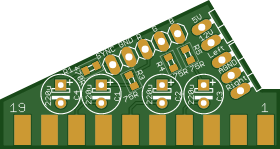 Universal Breakout RGB EURO SCART PERITEL video game console OSSC computer
Fully compatible with Euro SCART cables. Provides all necessary components for connecting retro vide...
Universal Breakout RGB EURO SCART PERITEL video game console OSSC computer
Fully compatible with Euro SCART cables. Provides all necessary components for connecting retro vide...
-
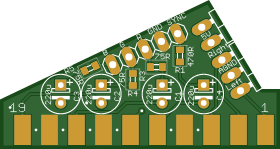 Universal Breakout RGB-J JP21 EIAJ TTC-003 XRGB MINI FRAMEMEISTER console computer
Minimal BOM and accurate signal conditioning enabling connections between any retro game console (or...
Universal Breakout RGB-J JP21 EIAJ TTC-003 XRGB MINI FRAMEMEISTER console computer
Minimal BOM and accurate signal conditioning enabling connections between any retro game console (or...
-
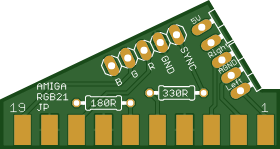 Commodore AMIGA 1000 500 600 2000 3000 4000 Breakout RGB-J JP21 EIAJ TTC-003 XRGB MINI FRAMEMEISTER
Minimal BOM and accurate signal conditioning enabling connections between Amiga models and XRGB Mini...
Commodore AMIGA 1000 500 600 2000 3000 4000 Breakout RGB-J JP21 EIAJ TTC-003 XRGB MINI FRAMEMEISTER
Minimal BOM and accurate signal conditioning enabling connections between Amiga models and XRGB Mini...
-
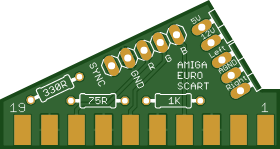 Commodore Amiga RGB SCART Breakout board 1000 500 600 1200 2000 3000 4000 EURO PERITEL OSSC
Fully compatible with Euro SCART cables. Provides all necessary components for connecting Amiga comp...
Commodore Amiga RGB SCART Breakout board 1000 500 600 1200 2000 3000 4000 EURO PERITEL OSSC
Fully compatible with Euro SCART cables. Provides all necessary components for connecting Amiga comp...
-
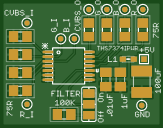 THS7374 4-Channel Rail-to-Rail Video Buffer for RGB, CVBS & CSYNC Signals
BOM list https://www.digikey.com/en/mylists/list/YLDCUPMRE3The THS7374 is a compact 4-channel rail-t...
THS7374 4-Channel Rail-to-Rail Video Buffer for RGB, CVBS & CSYNC Signals
BOM list https://www.digikey.com/en/mylists/list/YLDCUPMRE3The THS7374 is a compact 4-channel rail-t...
You may also like
-
-
mammoth-3D SLM Voron Toolhead – Manual Drill & Tap Edition
140 0 0 -
-
AEL-2011 Power Supply Module
653 0 2 -
AEL-2011 50W Power Amplifier
567 0 2 -
-
-
Custom Mechanical Keyboard
769 0 0 -
Tester for Touch Screen Digitizer without using microcontroller
395 2 2 -
Audio reactive glow LED wristband/bracelet with NFC / RFID-Tags
363 0 1 -
-




















